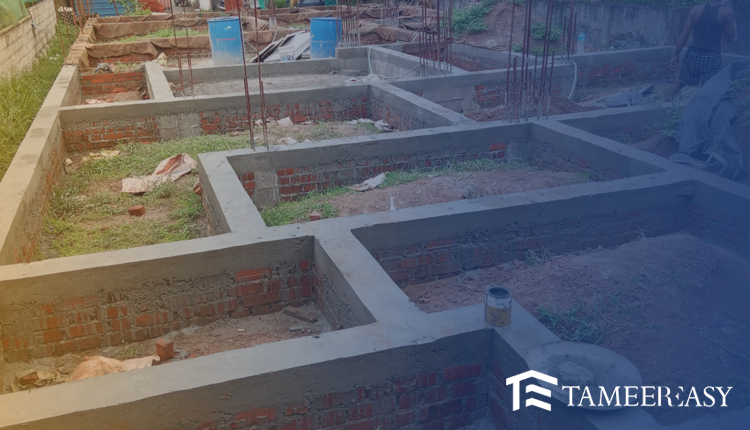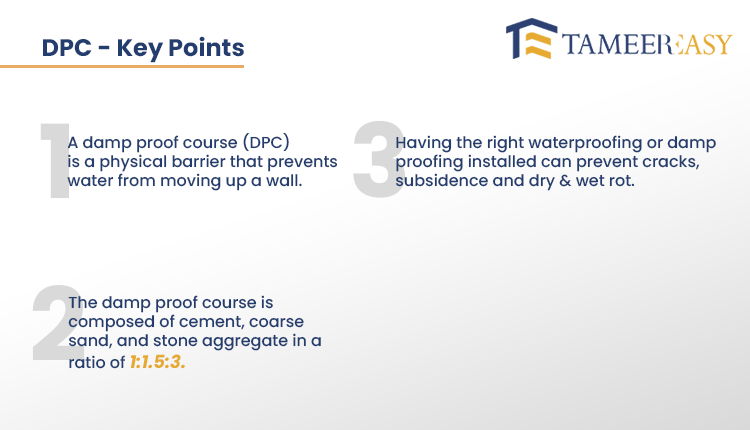Have you ever questioned the source of the sudden wetness in the walls? When your home’s paint starts to peel off, the walls get chalky, and even the plaster crumbles. All Pakistani homes were affected by these issues. Construction projects often require a lot of planning, but one key component often overlooked is the importance of a damp-proof course (DPC).
Visit TameerEasy Store to Purchase Quality Construction Items
In this article, we will discuss why it is so important to include a DPC in your construction project and what techniques you should use to ensure it is properly installed. Find out why the Damp Proof Course is essential to any quality construction project! We’ll also examine key techniques to understand the DPC process so you know exactly what must be done for a successful build. Let’s get started!

Causes of Moisture in the Walls
Water slowly rises from a house’s exterior wall or below the floor. If there does not impede the water’s path, gradually diminishes the aesthetic appeal of gorgeous walls. The house’s strength and beauty decline as the paint and plaster flakes off. DPC is the only obstacle to this water; If DPC is effective, you can prevent all these problems.
What does DPC Stand for in Construction?
The acronym DPC stands for the damp proof course. You may do this to protect your home’s walls and foundation against dampness. There are typically two different forms of Damp Proof Courses: horizontal and vertical. Simply put, you build a layer of concrete and then add tar and polythene sheeting, preventing water from leaking or passing.
Vertical DPC in Construction
Vertical DPC is put in to protect the home’s exterior wall from water. The level of our home is frequently higher than the nearby street or road, as we have seen. As a result, it is extremely simple for outside water to enter our home. To prevent this, we install Vertical DPC to the exterior wall. So according to the height of our house from the outside street, we protect the outer wall from water by adding Vertical DPC.
Process of Horizontal DPC in Construction
The horizontal DPC is quite significant and is often located in one location. But it ought to be divided into two tiers. One should be placed at the level of the road or street. Second, you should place Horizontal DPC at the home’s floor level before building the wall. It ensures that your wall is safe.
Method of the Concrete Layer in DPC
The most crucial step in this procedure is the bitumen coating after the concrete layer, followed by a polythene sheet. The most recent methods apply the cementation coating after the concrete layer. Bitumen and polythene sheeting are thus not required. Remember that the concrete layers’ size varies between the two types. The concrete layer is up to 1″ in a horizontal DPC and up to 2″ in a vertical Damp Proof Course.
Important Things to Keep in Mind While Installing the DPC
First, ensure the DPC is strong, especially when positioned around 1/2″ above the floor level. There is zero chance of it seeping through the wall if it remains in place. This means that if the Damp Proof Course is higher than the floor level, the water will also encounter a barrier, protecting your wall from dampness and other hazards.


What Steps Should We Take if Moisture Still Penetrates the Walls Despite Installing DPC?
In the past, the moisture would return after months of treatment use. However, this thing has emerged using the most recent approaches. This protects the paint and plaster of the walls for 5–6 years by peeling out a small portion of the wall’s plaster and applying chemical coats.
Conclusion
You all now understand the techniques used to protect the house’s walls against dampness. You can prevent the plaster and paint from falling with the help of DPC. If you have any questions, please post a note in our comment section or visit our website, tameereasy.com, for further advice on construction pieces.







